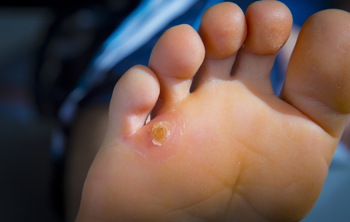Freehold (732) 294-9393
Freehold (732) 294-9393
 A corn on the foot is defined as a small area on the top of the toes or on the sole of the foot that has hardened as a result of excess pressure that is often caused by wearing shoes that do not fit correctly. It can cause severe pain and discomfort, and may feel better when a protective covering is worn over it. Additionally, corns may develop between the toes, and these are referred to as soft corns. The corn and surrounding area may feel better when it is soaked in warm water, and it is beneficial to wear shoes that are comfortable and fit properly. If you have developed corns on your feet, please consult with a podiatrist who can guide you toward treatment techniques that are correct for you.
A corn on the foot is defined as a small area on the top of the toes or on the sole of the foot that has hardened as a result of excess pressure that is often caused by wearing shoes that do not fit correctly. It can cause severe pain and discomfort, and may feel better when a protective covering is worn over it. Additionally, corns may develop between the toes, and these are referred to as soft corns. The corn and surrounding area may feel better when it is soaked in warm water, and it is beneficial to wear shoes that are comfortable and fit properly. If you have developed corns on your feet, please consult with a podiatrist who can guide you toward treatment techniques that are correct for you.
Corns can make walking very painful and should be treated immediately. If you have questions regarding your feet and ankles, contact Dr. Henry Miller of New Jersey. Our doctor will treat your foot and ankle needs.
Corns: What Are They? And How Do You Get Rid of Them?
Corns are thickened areas on the skin that can become painful. They are caused by excessive pressure and friction on the skin. Corns press into the deeper layers of the skin and are usually round in shape.
Ways to Prevent Corns
There are many ways to get rid of painful corns such as:
Treating Corns
Although most corns slowly disappear when the friction or pressure stops, this isn’t always the case. Consult with your podiatrist to determine the best treatment option for your case of corns.
If you have any questions please feel free to contact our office located in Freehold, NJ . We offer the newest diagnostic and treatment technologies for all your foot and ankle needs.